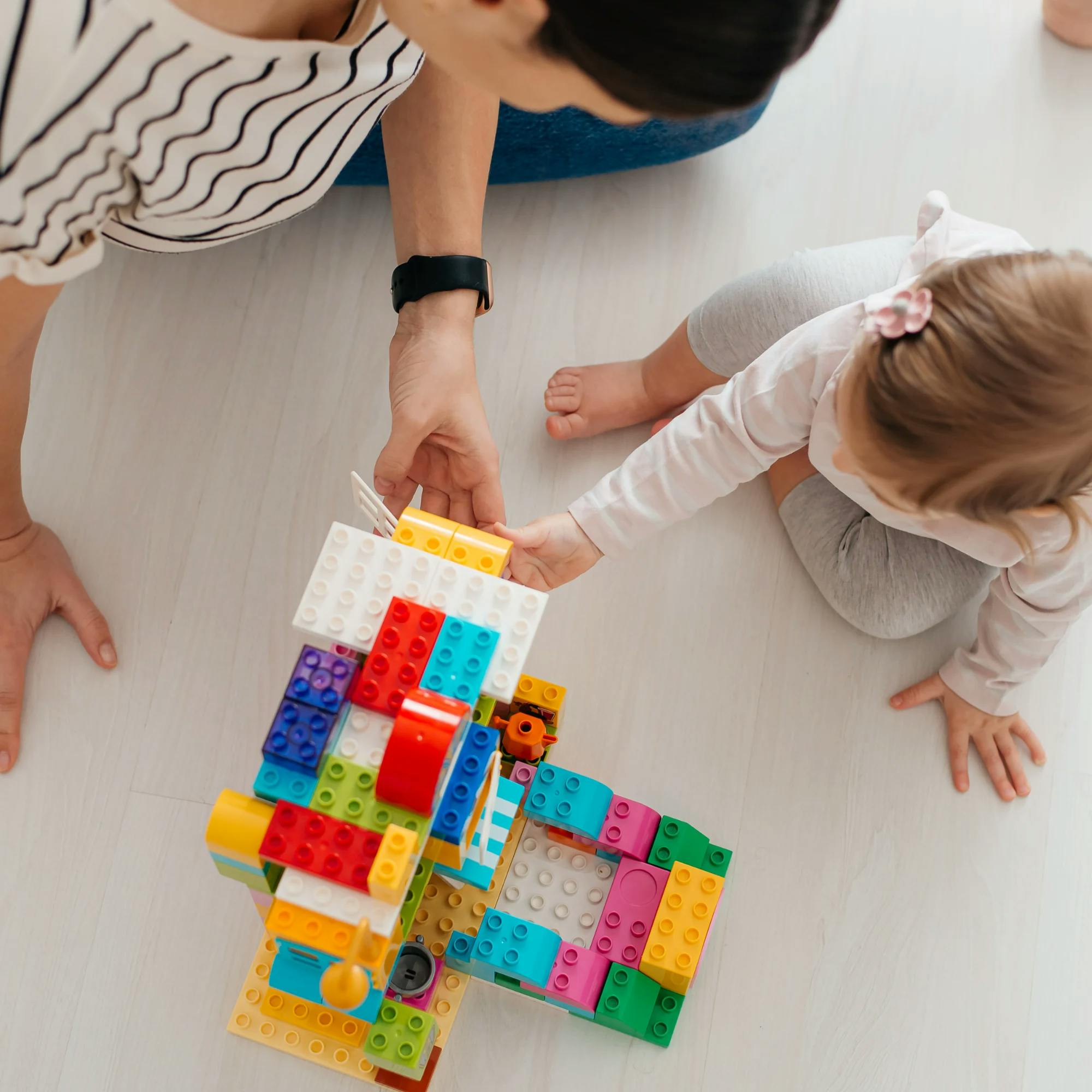A toddler’s first word is a big milestone. Children typically start talking around 12 months old, but that can vary by a few months.
If you’re still waiting for your child to talk, you may be wondering if you can help them along. The good news? You can, and the steps are pretty simple (and fun, too!).
Best of all, you can work on your child’s language skills during everyday routines. Let’s take a look at some practical ways to teach your toddler to talk during their daily activities.
Free speech check
How well is your child speaking for their age? Find out with our free 5-minute online screener. No signup required, just answers.
 Start the screener
Start the screenerA day in the life: Help your toddler talk during daily routines
1 During the morning routine
Getting your little one up and ready for the day can be challenging. There’s breakfast to make, teeth to be brushed, and clothes to put on. And you may be racing against the clock for daycare, school, or work. So let’s start with something easy: language modeling.
Language modeling simply involves narrating what you’re doing. Here’s an example. If you’re getting your child dressed, you might say, “Let’s put on your shoes! Shoes on” as you put each shoe on their foot. Or, when you zip up their jacket, you could say, “Time to put on your jacket. Zip up! Zip up your jacket.”
When you emphasize and repeat key words, it helps your toddler learn them. Focus on emphasizing nouns (“jacket”) and action words (“zip up”).

You can use language modeling just about anytime, anywhere. What’s also great about this technique is that your child doesn’t have to repeat your words, although the goal is for them to imitate you eventually. When you consistently model words for your child, it helps them learn to start talking.
An important note: Even if you model a two-word phrase or a full sentence, your child is likely to start talking by saying single words at a time. So they’re more likely to try to say “zip” than “zip up jacket.” You can certainly model sentences and phrases, but don’t expect your toddler to imitate them right away.
2 In the car
Now let’s say it’s time to get in the car. Whether you’re dropping your child off at daycare or going to the grocery store, there’s lots you can talk about together!
Try talking about things you see. Maybe you see a car, a train, and a motorcycle. Talk about the sounds these things make. If your child is still learning to produce and imitate early speech sounds, this is a great chance to practice the sounds of vehicles! Kids are often more motivated to make these types of sounds first. They’re easier to say–plus, they’re fun!
So start practicing those “Beep beeps” and “Vroom vrooms!” Give lots of models and opportunities for them to imitate you. While you’ve got some time alone in the car with your toddler, take advantage of it to work on their speech and language.


3 Lunch time or snack time
Now it’s time for lunch or an afternoon snack. This is the perfect time to work on offering choices. Choices are like a little magic trick that helps your child communicate what they want. It also teaches them how to start using more words.
Here’s how to do it:
If possible, show your child their options. If you ask, “What do you want to eat?”, show them their snack choices–say, crackers and a banana.
Say each word as you show them the food: “Do you want crackers, or a banana?”
Place one item in each of your hands. Maybe your child will point, reach, or somehow let you know which snack they want.
Prompt them to imitate the word. If they point to the crackers, you can say, “Crackers? Mmmm, you want crackers?” Even a simple answer like “Yes!” or “More!” would be a great response here!
You can also model the first sound for your child–“C-c-crackers!”–to see if they can imitate that sound.
You can offer choices with a snack, with toys, or with clothes when it’s time to get dressed. But here’s one important note: Don’t withhold the item from your child for too long. Just give your toddler a few chances to respond before handing over the snack or toy.


4 Going new places and trying new things
Look for ways to engage your child in something that interests them, whether it’s visiting the park or trying a new game or activity at home. Here are some ideas:
Visit a new park or playground
Go to a different grocery store
Let your child help make a meal
Let your child help with household tasks
Rotate toys every couple weeks so that they feel “new”
Take a walk in another neighborhood
Go to the library
Try a new art or craft project
When your child is engaged and interested in what they’re doing, they’re much more likely to want to talk about it. Try some of these activities and use the modeling techniques explained above to help your child imitate new words. Don’t put too much pressure on them, but talk to them often so the words soak in. Make sure to pause and give your child time to respond.


5 At bedtime
Now the day is done and it’s time to put your little one to bed. There are a couple more simple (and sweet) ways to practice helping them talk.
Snuggle up with a bedtime story together. Pick a book that your child will be interested in. Ask them questions about what they see. You might say, “Where is the dog?” or “Point to the house.” See if your child can identify the items. These are receptive language tasks, which focus on the language your toddler can understand. For many kids, receptive language is actually a precursor to speaking. So this is a great way to practice.
As you tuck your child into bed, try saying the same phrase each night. Maybe it’s “Night night!” or “I love you!” You can try modeling the phrase as a “fill-in-the-blank” to see if they’ll fill it in. So you might say, “I love _____ “ and see if they’ll say “you!” One day they might just say the whole phrase to you. Hearing the first “I love you” is a sweet moment for every parent!
Storytime, and bedtime in general, is also a good time to use “parentese” with your child. Parentese is a way of speaking that helps promote language development in young children. It can also help strengthen your bond. Here’s how you do it:
Speak at a higher pitch
Speak slowly and clearly
Elongate your vowels (for example, “Let’s read a boo-oo-k”)
Exaggerate your facial expressions (such as using lots of happy, surprised, or sad faces when reading a book or playing together)
Use a variety of engaging tones of voice
Use simple sentences with correct grammar
Check out this quick (and adorable) video showing parentese in action. These are easy changes you can make in the way you talk with your baby or toddler–and research shows it makes a difference in their language development!
Quick demo: The "wait time" technique helps your child learn to talk
Watch hereHow do you know if your toddler needs speech therapy?
Some children will need help from a licensed speech-language pathologist, also known as a speech therapist, in order to start talking. But how do you know when speech therapy is needed?
It helps to become familiar with speech and language milestones for children at different ages. If your toddler isn’t meeting these milestones, if they have trouble communicating daily, or if you’re noticing that they’re often frustrated, it may be time to talk to a speech therapist. Visit our Learning Center to learn more about speech and language milestones from birth to age 5 years.
When it comes to speech therapy, the “wait and see” approach can cause precious time to be lost. Early intervention is the best way to get your child caught up with the skills expected for their age. If your child isn’t meeting age-appropriate milestones and you’re even slightly concerned, start looking for a speech therapist. There may be a waitlist, so it may be awhile before a first appointment can take place.


How to find a speech therapist for your toddler
There are many things to consider when looking for a speech therapist, such as where therapy will take place (at your home, at a clinic, at school, or online) and whether you’ll be paying for therapy yourself or using insurance.
It’s also important to find a speech therapist who is skilled in working with toddlers. Speech therapists work in a variety of settings with clients of all ages. So spend some time researching the one who will be the best fit for your family.
How Expressable Can Help
Concerned your child isn't reaching age-expected milestones? Looking for communication support from a professional? Expressable is a national online speech therapy practice serving children and adults. We treat all major areas of communication and feeding, offer flexible hours including evenings and weekends, and accept most major health insurance plans. We’re proud to have earned more than 3,000 5-star reviews from our clients (4.9/5 average).
Our therapy model is centered on parent and caregiver involvement. Research proves that empowering caregivers to participate in their loved one’s therapy leads to better outcomes. That’s why we combine live, 1-on-1 speech therapy with personalized education and home practice activities for faster progress.
Communication is more than words. It’s how we share how we feel and show who we are. We’re here to help you or your child do just that.
 Abby Barnes, M.S., CCC-SLP
Abby Barnes, M.S., CCC-SLP








